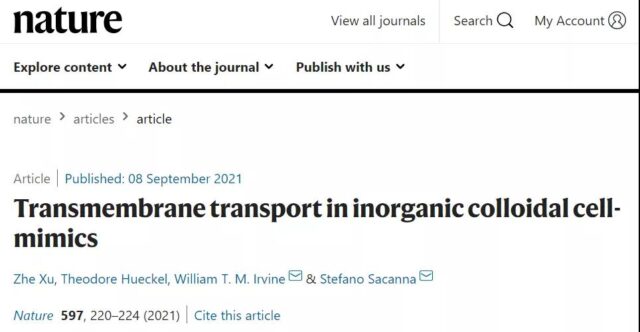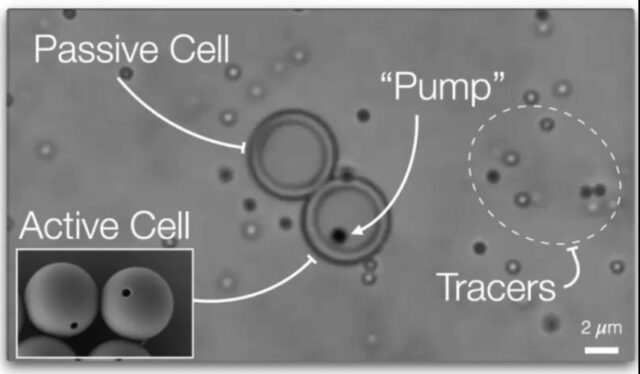Nature: The first “artificial cell” with active transport capability comes out
- Oregon Reverses Course: From Decriminalization to Recriminalization of Drug Possession
- Why Lecanemab’s Adoption Faces an Uphill Battle in US?
- Yogurt and High LDL Cholesterol: Can You Still Enjoy It?
- WHO Releases Global Influenza Vaccine Market Study in 2024
- HIV Infections Linked to Unlicensed Spa’s Vampire Facial Treatments
- A Single US$2.15-Million Injection to Block 90% of Cancer Cell Formation
Nature: The first “artificial cell” with active transport capability comes out
- Was COVID virus leaked from the Chinese WIV lab?
- HIV Cure Research: New Study Links Viral DNA Levels to Spontaneous Control
- FDA has mandated a top-level black box warning for all marketed CAR-T therapies
- Can people with high blood pressure eat peanuts?
- What is the difference between dopamine and dobutamine?
- How long can the patient live after heart stent surgery?
Nature: The first “artificial cell” with active transport capability comes out. A major breakthrough in synthetic biology: the first “artificial cell” with active transport capability comes out.
For decades, scientists in the field of bioengineering have been committed to the research of artificial cells, trying to simulate the characteristics and behavior of biological cells, exploring the microstructure of biological cells, and thus deeply understand the functions of biological cells.
For biological cells, one of its most basic and important functions is to obtain energy and nutrients from the environment and discharge metabolic waste. In particular, the energy-consuming active transportation function can help cells actively absorb necessary nutrients, store energy, and discharge waste.
However, for a long time, although various artificial cells can mimic the functions of biological cells well, they still lack the ability of active transportation.
Recently, a research team led by Professor Stefano Sacanna from the Department of Chemistry of New York University and Professor William TM Irvine from the Department of Physics of the University of Chicago published research papers in the top international academic journal Nature, using synthetic materials, and successfully created an active transport capability. Brand new cell mimics.
Specifically, they used artificial polymers to create a spherical membrane the size of red blood cells, drilled a nanochannel in the membrane, and added a chemically reactive material to the nanopore to act as a pump. When activated by light, this material will produce a chemical reaction, forming a vacuum, and actively suck the extra-membrane material into the cell. When the chemical reaction is reversed, the pump can remove the intracellular material from the cell.

Regarding the results of this study, Professor Sacanna, one of the corresponding authors of this article, said, “The core of the cell structure design is to coordinate the physical separation of the cell membrane to provide power from the inside to enable it to ingest, process and exclude foreign bodies. The artificial cell simulation we designed For the first time, objects have realized the function of active transportation.”
Artificial cells, the dream of synthetic biologists
Cells are the basic building blocks of life. The analysis of cell structure, function and behavior is of great significance for exploring the mystery of life, the mechanism of disease generation, and disease treatment and diagnosis.
Although significant progress has been made in cell biology research, due to the complexity of cell structure, how the tens of thousands of genes, as well as the countless small molecules and organelles in the cytoplasm, coordinate to perform basic life functions to maintain life. The mechanism is not fully understood.
In the past, biological research has always focused on top-down, that is, how the composition of cells and genes function, and how their functions are. Now, advances in biological technology can enable researchers to adopt a bottom-up strategy to reconstruct cellular biological processes, the so-called artificial cells.
Artificial cells are simplified cell models constructed artificially, which can effectively overcome many problems faced in traditional cell research, are conducive to the study of the molecular mechanism of action within and between cells, and help establish the connection between living and non-living systems. Research on the origin of life provides the corresponding theoretical basis.
For a long time, artificial cells have been very attractive to synthetic biologists. Compared with simple liposome-like cell structures, artificial cells with complex functions are more sensitive to the environment and can perform more kinds of tasks, such as precise drug delivery, cancer cell tracking, toxic compound detection, and so on. The artificial cell matrix with interaction function can form artificial intelligence materials that perceive and adapt to the environment.
Generally speaking, building an artificial living cell from scratch needs to meet three conditions: reliable cell membrane and microenvironment, dynamic genetic regulation and self-replication, and spatially organized cytoskeleton to support 3D biological structure and cell replication. However, for a long time, scientists have mainly focused on the field of genetic information.
For example, as early as 2001, the research team led by the well-known biologist Dr. Craig Venter successfully constructed the world’s first manmade cells after spending 15 years and spending more than 40 million US dollars.
In 2021, the research team led by Professor Elizabeth Strychalski, head of the NIST cell engineering team, has successfully created “cells” that can grow and divide normally by adding synthetic genes.
In contrast, progress in the field of cell membranes and cytoskeleton has been slow, especially in the field of cell membranes, and there has been almost no breakthrough in recent years.
The first “artificial cell” to achieve active transportation
Obviously, for bioengineers, it is not enough to perform certain functions of cells alone, such as protein production and DNA replication. Only by designing a complete cell structure and realizing the cooperation of various units can fully synthetic artificial cells be truly realized.
The artificial cell membrane is undoubtedly a very important part of this.
The cell membrane seems to have a simple structure, but it maintains a stable internal microenvironment, controls the exchange of internal and external substances, assists the cytoskeleton in shaping the cell shape, and carries a variety of protein machinery to achieve various physiological functions. It is one of the most basic life components of cells.
In particular, the active transport function of cell membranes ensures that living cells actively choose to absorb the nutrients they need in accordance with the needs of life activities, discharge waste generated by metabolism and substances harmful to cells, and complete the basic guarantee for various life activities.
In order to design cell mimics, the researchers first used polyhedral oligomeric silsesquioxane, methacryloxypropyltrimethoxysilane and other polymers to create a red blood cell-sized cell membrane to control the entry and exit of substances. At the same time, they drilled a micropore in the spherical membrane to form a nanochannel, which was used to simulate the protein channel for material exchange.
We all know that the cell membrane needs to consume energy in the process of active transport. For living biological cells, mitochondria and ATP are the source of energy. In the artificial cell simulation, Professor Sacanna and others added a solid photocatalyst to the nanochannel.
When activated by light, this catalyst will form a tiny vacuum environment through a chemical reaction and pull surrounding materials into the cell membrane. When the light stops, the substance is stored in the cell membrane to react. At the same time, this chemical reaction can be reversed and used to excrete waste.

“Artificial Cells” with Active Transport Function (Source: New York University)
Subsequently, the researchers tested this cell mimic in different environments. In an experiment, they suspended the cell mimics in water, activated them with light, and found that they can actively take in substances from the surrounding water. This means that this cell simulant may be used to clean up environmental pollutants in the future.
In this regard, Professor Sacanna said, “This is like a game of peas, our cell simulants can collect pollutants everywhere and remove them from the environment.”
In another experiment, the researchers also confirmed that cell mimics can swallow E. coli and trap them in the membrane, which may provide a new way to fight bacteria in the body.
Another future application of such cell mimics may be drug delivery, as they can release pre-loaded substances when activated. Currently, researchers are continuing to develop and study this cell mimic, including constructing cell mimics with different functions, and exploring how different cell mimics communicate.
(source:internet, reference only)
Disclaimer of medicaltrend.org
Important Note: The information provided is for informational purposes only and should not be considered as medical advice.



